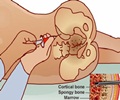Blinatumomab Medication Information
Discover comprehensive details about Blinatumomab, including its pronunciation, uses, dosage instructions, indications, and guidelines on how and when to take it or avoid it.
The updated prescription information covers potential side effects, precautions, warnings, and storage recommendations.
Additionally, explore the Blinatumomab brands available in India and internationally, along with pricing information. For personalized advice, consult your healthcare provider.
Generic Name : Blinatumomab Pronunciation : blih-nuh-TOO-moh-mab Therapeutic Classification : ChemotherapyBrand Names or Trade Names of Blinatumomab
India :
Blincyto
Why is Blinatumomab Prescribed? (Indications)
Blinatumomab is used to treat B-cell precursor acute lymphoblastic leukemia (ALL), a type of cancer of the white blood cells in adult patients and children.Blinatumomab is used to treat ALL in patients whose symptoms and signs of cancer are decreased but present with a minimum residual disease (MRD) score either greater than or equal to 0.1%.
It is also used to treat patients’ relapsed cancer or who’s ALL returns back after successful treatment.
Blinatumomab is a monoclonal antibody that belongs to bispecific T-cell engager antibodies and targets the CD19 antigen present on B lymphocyte cell, a type of white blood cell. This results in either slowing down or stopping of cancer cell growth in the body.
When should Blinatumomab not be taken? (Contraindications)
Blinatumomab should not be used in patients-• If there is an allergy to blinatumomab
• Pregnancy and breastfeeding
• Less than 22 kg body weight
Patients should not receive any live virus vaccines for at least 2 weeks before starting the blinatumomab therapy, during the treatment and until immune recovery after the last cycle of blinatumomab.
What is the dosage of Blinatumomab?
• The dose of blinatumomab is recommended based on patients’ body weight and the treatment schedule.• Dose adjustments can be done to reduce the severity of the side effects. If the treatment cycle is temporarily stopped for just less than 1 week due to the occurrence of side effects, continue the treatment cycle for a total of 28 days including the days before and after the interruption of the cycle.
• If the interruption of blinatumomab has been withheld for more than seven days due to the side effects, a new treatment cycle of blinatumomab should be started.
• The treatment with blinatumomab should be discontinued permanently if the side effects are life-threatening.
Treatment of B-cell precursor acute lymphoblastic leukemia:
• The treatment course of blinatumomab consists of 1 cycle (42 days) followed by three cycles.
• One cycle of blinatumomab includes 28 days of continuous intravenous infusion followed by a 14 day treatment-free period.
• Patients who weigh 45 kg and above must be given a fixed dose of 28 mcg/day for the first 28 days followed by 2 weeks of treatment-free interval.
• For patients who weigh less than 45 kg, the dose of blinatumomab should be calculated based on the body surface area. These patients are usually given 15 mcg / m2 / day for the first 28 days followed by no treatment with blinatumomab for the following 14 days (29 - 42 days).
• Hospitalization is generally recommended for the first 3 days of the first cycle and the first 2 days of the second cycle. However, the following treatment cycle of blinatumomab requires medical supervision.
• Patients can be pre-medicated with steroids before starting the blinatumomab treatment cycle.
Adult patients:
• Prednisone 100 mg or dexamethasone 16 mg can be given directly into the vein 1 hour before the first dose of each treatment cycle.
Pediatric patients:
• Dexamethasone 5 mg/m2 can be given before the first dose of blinatumomab during the first cycle. The same schedule can be followed while an infusion is stopped for more than 4 hours for some reasons.
Treatment of refractory or relapsed B-cell precursor ALL:
• The treatment course of blinatumomab consists of 2 cycles initially followed by three supportive or consolidated cycles and 4 additional cycles.
• The initial or the supporting cycle consists of 28 days of treatment with blinatumomab followed by a treatment-free period of 14 days.
• The additional treatment cycle consists of 28 days of blinatumomab infusion followed by a treatment-free interval of 56 days.
Patients who weigh 45 kg and above must be given a fixed dose of 9 mcg/day for the first 1-7 days, 28 mcg/day from day 8 to 28 days followed by a treatment-free interval of 14 days during the first cycle.
• In the second cycle and subsequent supportive or consolidated cycles, patients who weigh 45 kg and above must be given 28 mcg/day from day 1 to 28 followed by a treatment-free period of 2 weeks.
• The dose in continuous cycle involves blinatumomab 28 mcg/day for the first 1 to 28 days followed by a treatment-free interval of 56 days.
Patients weighing less than 45 kg should take a dose based on the body surface area (BSA).
• First Cycle: Patients should be given 5 mcg/m2/day for 1 week, 15 mcg/m2/day from 8 to 28 days followed by a treatment-free period of 14 days.
• Cycles 2 to 5: Patients should be given 15 mcg/m2/day for 1 to 28 days followed by a treatment-free period of 14 days from the 29th to the 42nd day.
• Cycles 6 to 9: Patients should be given 15 mcg/m2/day for 1 to 28 days followed by a treatment-free period of 56 days from the 29th to the 84th day.
• Hospitalization is generally recommended for the first nine days of the first cycle and early 2 days of the second cycle. However, other treatment cycles require medical supervision.
• Patients can be pre-medicated with dexamethasone (20 mg for adults and 5 mg/m2 for children) 1 hour before the first dose of blinatumomab during each cycle and whenever the cycle is interrupted. Hospitalization is generally recommended for the first three days of the first cycle and first 2 days of the second cycle. However, the following treatment cycle requires medical supervision.
How should Blinatumomab be taken?
• Blinatumomab is available as an intravenous infusion which should be given directly into the vein at a constant rate with the help of an infusion pump very slowly for a period of 24 to 48 hours.• The contents of the blinatumomab vial should be mixed into the IV (intravenous) bag containing 0.9% sodium chloride and IV solution stabilizer. The mixing should be done very gently to avoid foaming.
• Never flush the IV line once the blinatumomab infusion is completed or while changing the infusion bags as it may result in overdose or other complications.
What are the warnings and precautions for Blinatumomab?
•Women of childbearing age should be verified for pregnancy status before starting the treatment with blinatumomab as it may harm the fetus.Females of reproductive potential living with an active male partner should use adequate contraceptive measures during the treatment with blinatumomab and should continue the contraception for at least 48 hours after the last dose of blinatumomab.
Patients must be monitored for symptoms and signs of the following side effects-
• Tumor Lysis Syndrome
• Infections including viral, bacterial, fungal or catheter-site infections
• Cytokine Release Syndrome
• Nerve disorders
• Pancreatitis
• Leukoencephalopathy
• Abnormal lab values of liver enzymes and neutrophils
Patients on blinatumomab treatment must be advised to consult the doctor if the side effects are severe. The treatment with blinatumomab can be discontinued permanently if the side effects are life-threatening.
Blinatumomab can affect mental alertness and patients should be advised not to perform skilled tasks such as driving, operating heavy machinery, or handling hazardous chemicals.
What are the side effects of Blinatumomab?
Nervous system: Confusion, headache, dizziness, tremor, inability to sleep, altered state of consciousness, seizures, speech disorder, mood disorders such as depression and suicidal thoughtsBlood: Fluctuations in blood pressure, abnormal heart rhythm, blood disorders
Respiratory: Difficulty in breathing, cough, wheezing, chest tightness, respiratory failure
Lab abnormalities: Abnormal levels of bilirubin, alkaline phosphatase, liver enzymes, neutrophils, gammaglobulin, immunoglobulin
Others: Infections, fever, muscle pain, bone pain, rashes, infusion-related reactions, decreased weight, pain in the legs and hands
What are the other precautions for Blinatumomab?
• During the treatment with blinatumomab, efforts should be taken to minimize administration errors such as overdose or low dose and to avoid contamination during the preparation.• The infusion mixture stored in cold storage or refrigerator should be allowed to come to room temperature before administering to the patient.
What are the Drug Interactions of Blinatumomab?
• The drugs with a narrow therapeutic index such as warfarin, theophylline, cyclosporine, and phenytoin should be administered very carefully with blinatumomab as these could result in toxicity or loss of response.• The risk of drug-drug interactions is high mainly during the first nine days of the first cycle of blinatumomab infusion and the first 2 days of the second cycle. So, dose reductions can be considered to avoid dangerous drug reactions.
What are the storage conditions for Blinatumomab?
• The vials of blinatumomab and IV solution stabilizer vials should be stored in a refrigerator between 2°C and 8°C.• The reconstituted vials should be used within 4 hours if stored at room temperature and within 24 hours if stored at 2°C and 8°C.
• The infusion bag containing blinatumomab prepared without preservatives must be stored below 25°C and should be used within 48 hours. If stored at 2°C and 8°C, it should be used within eight days.
• The infusion bag of blinatumomab prepared with preservatives should be used within seven days if stored at room temperature (below 25°C) or 14 days if stored in a refrigerator (2°C to 8°C).









